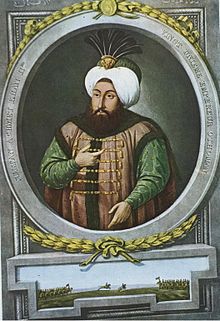Ahmet II
| Ahmed II احمد ثانى |
|||||
|---|---|---|---|---|---|
| Sultan of the Ottoman Empire Custodian of the Two Holy Mosques Caliph of Islam |
|||||
 |
|||||
| 21st Ottoman Sultan (Emperor) | |||||
| Reign | 22 June 1691 – 6 February 1695 | ||||
| Predecessor | Suleiman II | ||||
| Successor | Mustafa II | ||||
| Born | 25 February 1643 Constantinople, Ottoman Empire |
||||
| Died | 6 February 1695 (aged 51) Edirne, Ottoman Empire |
||||
| Consort |
Rabia Sultan Şayeste Kadın |
||||
| Issue | see below | ||||
|
|||||
| Dynasty | Ottoman | ||||
| Father | Ibrahim | ||||
| Mother | Hatice Muazzez Sultan | ||||
| Tughra |  |
||||
| Full name | |
|---|---|
| Ahmed bin Ibrahim |
Ahmed II (Ottoman Turkish: احمد ثانى Aḥmed-i sānī) (25 February 1643 – 6 February 1695) was the Sultan of the Ottoman Empire from 1691 to 1695. Ahmed II was born at Topkapı Palace, Constantinople, the son of Sultan Ibrahim (1640–48) by Hatice Muazzez Valide Sultan, and succeeded his brother Suleiman II (1687–91) in 1691.
Ahmed II was born on 25 February 1643, the son of Sultan Ibrahim and Hatice Muazzez Sultan. During reigns of his older brothers, Ahmed was imprisoned in Kafes, and he stayed there almost 43 years.
During his short reign, Sultan Ahmed II devoted most of his attention to the wars against the Habsburgs and related foreign policy, governmental and economic issues. Of these, the most important were the tax reforms and the introduction of the lifelong tax farm system (malikane) (see tax farming). Following the recovery of Belgrade under his predecessor, Suleiman II, the military frontier reached a rough stalemate on the Danube, with the Habsburgs no longer able to advance south of it, and the Ottomans attempting, ultimately unsuccessfully, to regain the initiative north of it.
Among the most important features of Ahmed’s reign was his reliance on Köprülüzade Fazıl Mustafa Pasha. Following his accession to the throne, Sultan Ahmed II confirmed Köprülüzade Fazıl Mustafa Pasha in his office as grand vizier. In office from 1689, Fazıl Mustafa Pasha was from the famous Köprülü family of grand viziers, and like most of his Köprülü predecessors in the same office, was an able administrator and military commander. Like his father Köprülü Mehmed Pasha (grand vizier 1656–61) before him, he ordered the removal and execution of dozens of corrupt state officials of the previous regime and replaced them with men loyal to himself. He overhauled the tax system by adjusting it to the capabilities of the taxpayers affected by the latest wars. He also reformed troop mobilization and increased the pool of conscripts available for the army by drafting tribesmen in the Balkans and Anatolia. In October 1690 he recaptured Belgrade (northern Serbia), a key fortress that commanded the confluence of the rivers Danube and Sava; in Ottoman hands since 1521, the fortress had been conquered by the Habsburgs in 1688.
...
Wikipedia
